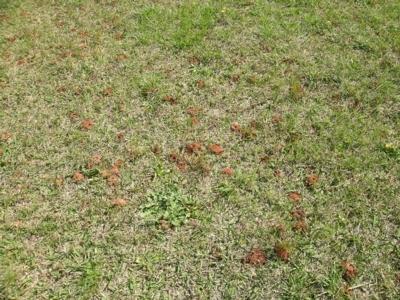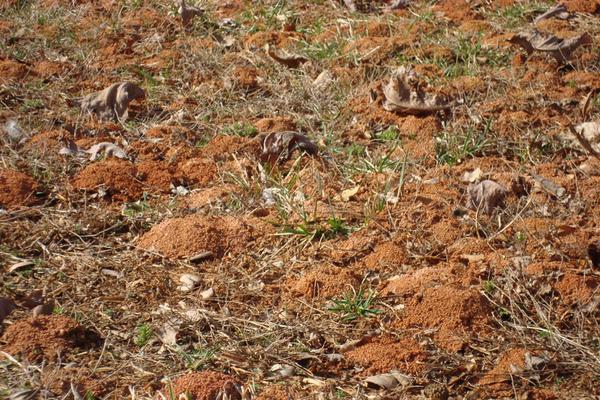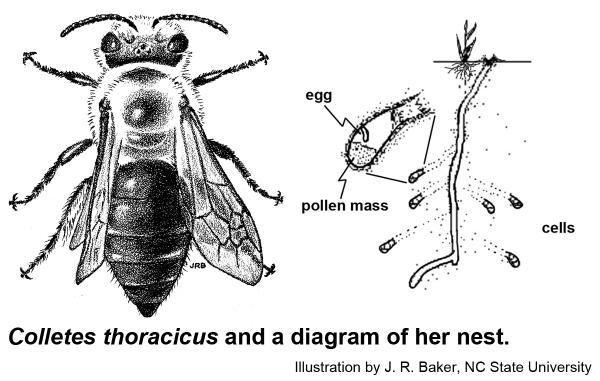General Information
Many common species of solitary bees nest in individual holes in the ground. They are all good pollinators. These bees range in size form 1⁄2 to 3⁄4 inches and may be a variety of colors such as black, blue, green, copper or metallic reddish-brown. They may belong to one of several groups of bees such as the membrane bees, digger bees, sweat bees, mason bees and leafcutter bees (Colletidae, Halictidae, Andrenidae, Anthophoridae, Megachilidae); native bees that occur across North Carolina. During the evening hours, females excavate nesting burrows that reach six or more inches in depth. Some of these bees line the burrow with a water-proofing secretion for protection from moisture. Small mounds of excavated soil may appear around each nest opening. When bees are numerous, many holes may be in closed proximity, creating a "citylike" aggregation. Each hole belongs to an individual female. During the day, the active females collect pollen and nectar to carry back to the nest to form a "ball" 1⁄8 to 1⁄4 inch in diameter that is placed within a "cell" excavated in the side of the burrow. A single egg is laid upon the pollen ball in March, April or early May. After hatching, the larva feeds on pollen and develops within the cell as part of a new generation of bees. The new generation emerges the following year in March or April. At this time, mating takes place and bee activity begins to pick up as the nesting cycle resumes. Though adult bees feed on nectar, none store honey as such. Solitary, ground-nesting bees play a vital role in ecological systems, especially in pollination of crops and wild plants. Because solitary bees are valuable pollinators they should not be destroyed unless there is some compelling reason such as pathological entomophobia.
Ground-nesting bees generally prefer nesting in areas with morning sun exposure and well-drained soils containing little organic matter. Burrows are excavated in areas of bare ground or sparse vegetation. These bees usually avoid damp soils. Damage to lawns and turf is usually minimal and control is often sought because the bees are perceived as a danger or annoyance. Solitary bees are not "programmed" to sting people and there is no mass attack as might be found with social hymenoptera such as honey bees or yellowjackets. A person might be stung if handling one roughly or if one becomes trapped in clothing. Mowing and other outdoor activities can be continued with little problem. However, with very large aggregations, the faint-of-heart may prefer to avoid the area for about 4 weeks while nesting is taking place.
Pest Management
Cultural control methods include heavy watering or irrigation with a lawn sprinkler during the nest-building period to discourage nesting. Tilling of soil to destroy tunnels may help a little, but establishment of dense turf is probably the best discouragement to further nesting. Applications of heavy organic matter could be included as a soil amendment, if practical, when tilling the soil. If the soil or location is not conducive to a healthy lawn, using ground covers or heavy mulches may be an alternative solution. Mulches may be used on bare patches caused by heavy traffic where grass will not grow.
Chemical Treatment
If chemical treatment is desired, recommendations for insecticides approved for control of these insects in home lawns can be found under bees and wasps in the insect control chapter of the North Carolina Agricultural Chemicals Manual. Recommendations for insecticides approved for use on sod farms, golf courses or other commercial sites can be found in commercial turf section of the North Carolina Agricultural Chemicals Manual.
Other Resources
- Bee Diversity. Anonymous. No Date. Bee Lab. University of Minnesota.
- 2021 Pest Control for Professional Turfgrass Managers. Bowman, D. et al. 2017. NC State Extension Publication AG-408.
- NC State Extension Plant Pathology Publications
- NC State Extension Horticultural Science Publications
- North Carolina Agricultural Chemicals Manual
For assistance with a specific problem, contact your local Cooperative Extension center.
Publication date: Jan. 1, 2009
Recommendations for the use of agricultural chemicals are included in this publication as a convenience to the reader. The use of brand names and any mention or listing of commercial products or services in this publication does not imply endorsement by NC State University or N.C. A&T State University nor discrimination against similar products or services not mentioned. Individuals who use agricultural chemicals are responsible for ensuring that the intended use complies with current regulations and conforms to the product label. Be sure to obtain current information about usage regulations and examine a current product label before applying any chemical. For assistance, contact your local N.C. Cooperative Extension county center.
N.C. Cooperative Extension prohibits discrimination and harassment regardless of age, color, disability, family and marital status, gender identity, national origin, political beliefs, race, religion, sex (including pregnancy), sexual orientation and veteran status.







